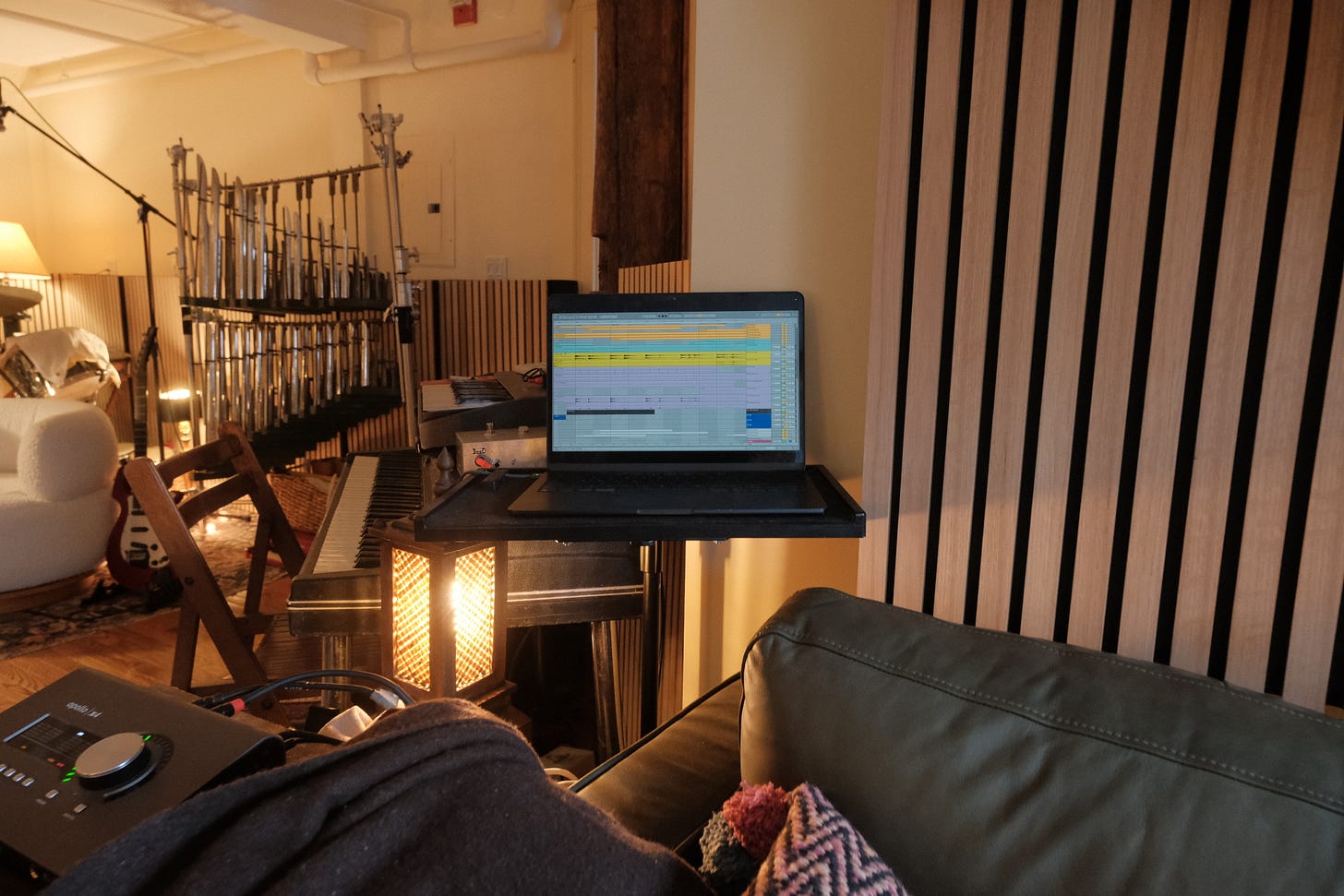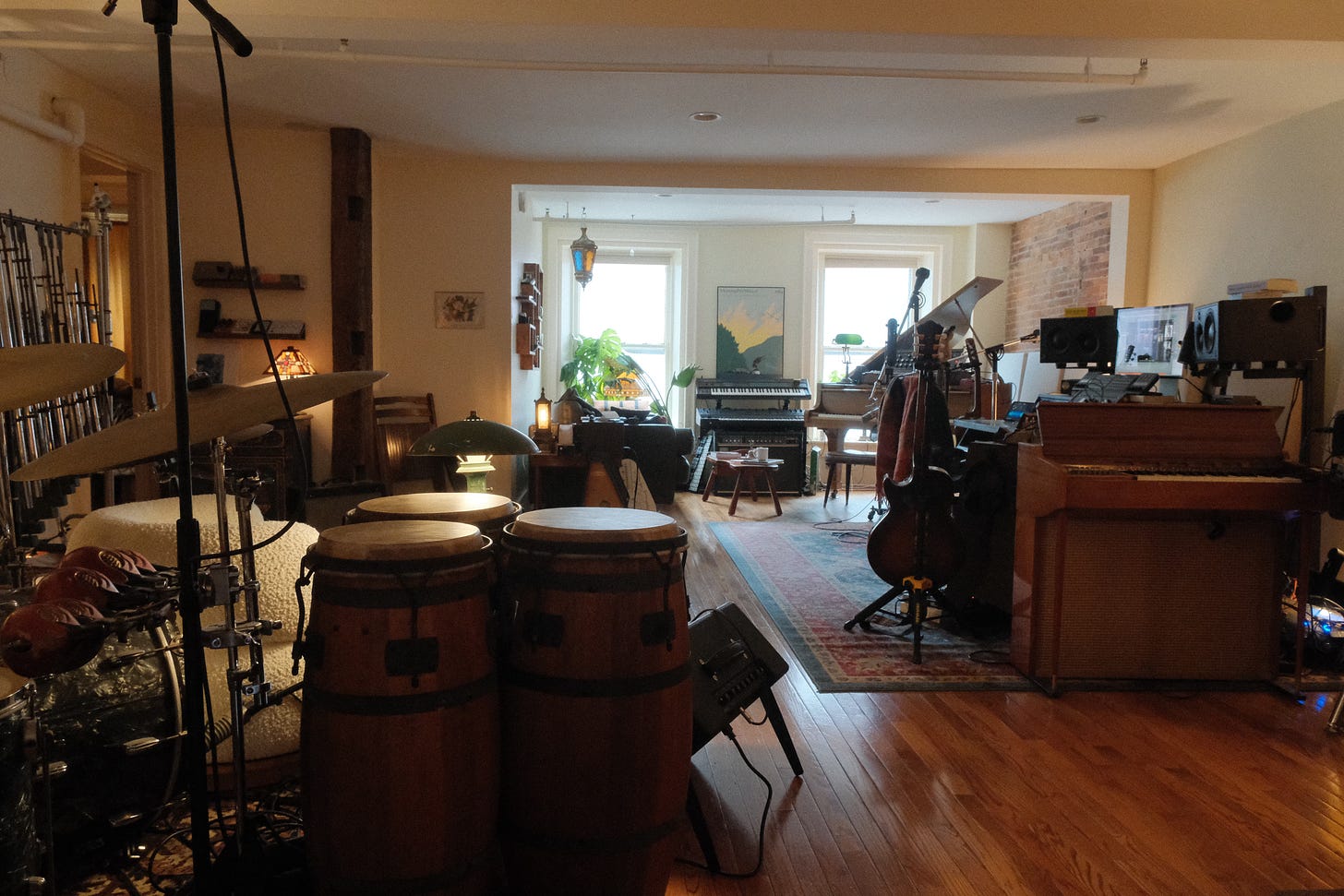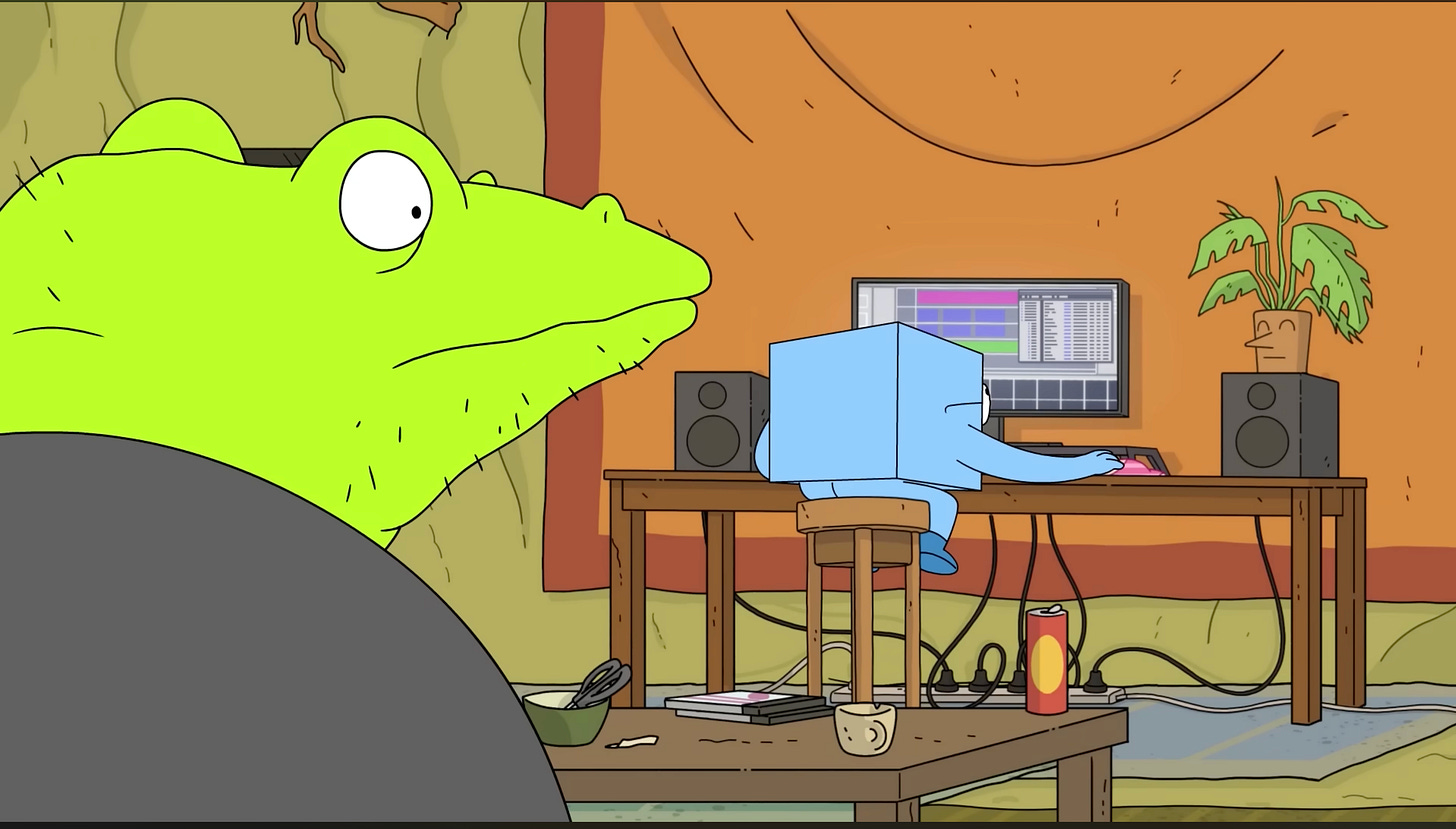My screen sharing setup: solving problems for the modern studio musician
The tyranny of the desk
Recording studios: my favorite kind of room. Each one has its own signature, reflecting something special about the artist who built and now inhabits it.
Today’s home studios are having something of a moment. I’m increasingly delighted when I enter many artists and producers’ home studios; they seem more carefully considered than ever. There’s a tasteful smattering of instruments, equipment, writing tools. Some of them are messy and cramped, full of toys and nests of patch cables. Others are minimal, essentialist. Many of them are built in homes, an extension of the artist’s living space.
Besides this charmed affair, I’m also occasionally in commercial studios, or rooms set up by label A&Rs, for what are meant to be collaborative sessions. Typically, I’m the producer, working with an artist or group. We’re sometimes joined by songwriters, instrumentalists, lyricists and friends, all crowded into one tiny room.
Yet nearly all of these creative spaces—from the big-name ones, to bedroom affairs—suffer from the same problem. And if you were to spy upon a writing session in one of these rooms, you’d feel it immediately, by the body language of the participants:
the tyranny of the desk
An open secret for you: the people who create the music you love these days are, largely, sitting at desks behind computer screens. Less “Abbey Road, Studio Two,” more “home office.” Many of them have steadfastly decorated their desk with accoutrements: nice speakers, a big screen, a sizable MIDI keyboard. Each upgrade makes the production workflow a little smoother. In total, they do something else: they anchor our bodies to one position in the room.
This isn’t necessarily a problem when making music by yourself. Yet problems abound when trying to make music with other people.
I can’t count the number of times I have been in a room with this exact configuration: a room whose centerpiece is a desk, a chair facing that desk, a set of speakers up against that desk, and a producer, his back turned away from the other people in the room, hunched over that desk.
Add an obligatory couch that’s directly behind that desk, where guests sit—far away, on the back wall. Easily 95% of the rooms I’ve visited are set up like this.
This layout leads to a host of problems that universally affect the experience of our sessions:
Lack of sight lines between collaborators: We musicians are social beings. We look at each other for cues; we sneak glances at what chords the other is playing. We watch for tiny reactions, a change of posture, a head bob. We challenge each other, play around, provoke laughter. Stir up emotion. The modern studio isn’t designed for these interpersonal moments to happen.
Centralized decision-making: He who sits at the desk and operates the computer, by default, has all the power. This power is theirs to grant or else jealously hoard, permitting no ideas beyond their computer and studio monitors. As a matter of course, those on the couch are relatively helpless, except to call out suggestions, trying to be heard over the 6-inch speakers the producer has next to their ears.
The one-man band: The rules of the desk-dominated command center are clear: every instrument, in arm’s length of the spacebar. Others shan’t come near. I’m reminded of the tottering one-man band, strutting down a busy thoroughfare, blaring horns and accordions. On social media, I’ve seen desk zones so maximalist as to strain belief: a cramped rotunda of synths piled five levels high, with barely enough room for one producer to inch their ergonomic chair. When I see these rooms, my first thought is, “What’s it like to collaborate with this person?”
Backseat driving: How does it feel to have someone in the backseat of your car, telling you where to turn? How about when they’re sitting in the passenger’s seat, next to you? One feels significantly more hostile and aggravating than the other. In our studios, we’ve created an environment in which every producer—back turned to the artist—feels slightly annoyed (at the very least, disrupted) at every request the artist makes of them, and every artist feels slightly shy to speak up.
Why does this happen? Why do I keep walking into studios—from million-dollar affairs to modest bedrooms—which seem to be oriented around the convenience of a single, chair-bound person?
It’s all back to the computer. By default rather than conscious choice, the computer is where all major creative decisions get executed. We rarely sketch ideas without immediately recording them to the computer. As long as we write, record, and perform all at once, it’s all too easy for the person who controls the mouse to control the whole process.
It is to my collaborators’ detriment if they are implicitly told to sit on the couch, far from the action, and wait as the music is rendered for them.
I hardly blame the artists who spend these sessions on the couch, scrolling listlessly on their phones. If you don’t feel included, why bother paying attention?
it doesn’t have to be like this
Consider another place where musical ideas are worked out, though increasingly rarely: the rehearsal space.
A modest rehearsal space isn’t much larger than a typical bedroom studio, but it’s oriented completely differently. It’s essentially a large living room used for laying out setups, playing together, and trying out ideas.
Here, band members disperse. They take over corners of the room to set up little stations, their own mini ecosystem. The guitarist has one. The drummer has one. Even those Ableton wizards man their own station, one part of the ensemble.
Sight lines take priority. People orient their rigs so they can see what everyone else is doing. They can talk to each other easily and make decisions together.
Musicians play with small amps, floor monitors, or adjust their playing so they can hear everyone else. The floor plan encourages listening, playing for the group, and musicality.
I think it’s no accident that some of the most creative bands credit their collective breakthroughs with hours sweating away in rehearsal rooms.
The tradeoff: as we optimize our solo workflow for comfort and convenience, we make collaborating with others less enjoyable and fair.
a way out
I’ve thought about this problem a lot in my time as an artist and producer. Desk-centric spaces are so ubiquitous that people don’t notice the many problems.
Nonetheless, among seasoned producers, you will hear chatter about these issues. How do you connect with an artist whom you’re rarely facing?
I’ve heard of a few tactics: a screen by the couch, mirroring the one at the desk, to give the artist an unobstructed view of what the producer is doing (not a bad idea). A rearview mirror by the desk, to better make eye contact with the artist (a producer friend of mine is known for doing this).
In the past, I’ve brought lengthy USB cables to hook my laptop to the studio interface, which lets me swivel my body around and face the artists as I work (what a difference!).
But the permanent solution I’ve found, thanks to some recent advances in technology, is so easy—so accessible—that I really think every producer or engineer with a room and frequent sessions should try it.
Here’s what I’ve found, and how you can set up your room to work this way, too.
a DAW that can go anywhere—with screen sharing
It is rare for a new technology to solve the problems that technology itself has caused. But occasionally, it does just that.
In my room, I have a second laptop. It’s a small, inexpensive MacBook Air, and it has one job: to run the whole studio from anywhere.
Be not confused: my main studio computer is still plugged in, dutifully minding the interface and its many USB connections. But these days—80% of the time—I run the studio wirelessly from my MacBook Air. I do it nearly every time I’m in a session with an artist.
The remote computer is showing me a 1:1 duplicate of the main screen, and I can record and produce as if I were sitting in front of the desk. Due to recent advances in both hardware encoders and software, you can get latency that’s so low (and a picture so crisp) that it feels like this laptop is the whole studio. Effectively, it is.
(In Part 2 of this post, I’ll detail the exact software I use to make this work, why I’ve settled on this specific software, and some of the implications and corollaries of having a wireless studio. You can subscribe here to get it in your inbox.)

This means that I can go anywhere. I can sit at the drums and track drums all day, without needing someone to helm the computer and push record. I can hyper-focus on tracking piano on an idea for hours, without returning to my desk.
With a wireless studio, you don’t just free the engineer, producer, or artist from the shackles of the desk; you introduce new ways to collaborate with each other.
When your collaborators want to make a change, you just pass them the laptop. Or let them hold onto it, and you can both work on the track in tandem. This leads to a very natural, playful switching-off—one of your collaborators can take over when you get tired and need a break.
If you work in my studio, you will almost never find me working with my back turned to you. I like to sit on the couch myself, or in a far-off chair, opening up the room to suggest that anywhere (and any instrument) is fair game. Oftentimes, my collaborators like to sit at the desk themselves, listening critically as I sit on the couch and edit the parts we recorded.
It also has let me radically redesign my room, spacing out my instruments far more generously than I ever have.
My ideal studio space is becoming much more like a rehearsal room: little stations all around it, some very far from the desk. The “desk” part—with the patchbay, preamps, and interface—is an area of the room. But it’s just one station; it can be ignored if desired.
This method doesn’t call for dismantling the desk and throwing it in a closet. But it dramatically reduces its importance. The desk is there for mixing or for more critical, solo work. I’ll be honest—I don’t spend too much time there! These days, I’m much more on my feet, playing “band practice” in the band we’ve made for that day.
It’s an exhilarating feeling to have back.
In Part 2, I’ll talk more about the implications I’ve found for my own work, and the details you’ll need to set all this up. Until then!





Part 2 Part 2 lets gooo
Insightful! For a while I was using an old MacBook Air for the same task using Apple’s built-in screen sharing/remote control, but the latency and screen size/scaling difference between the Air and my main display was annoying enough that I was never fully satisfied. I’m very interested to hear about your solution. Thanks!